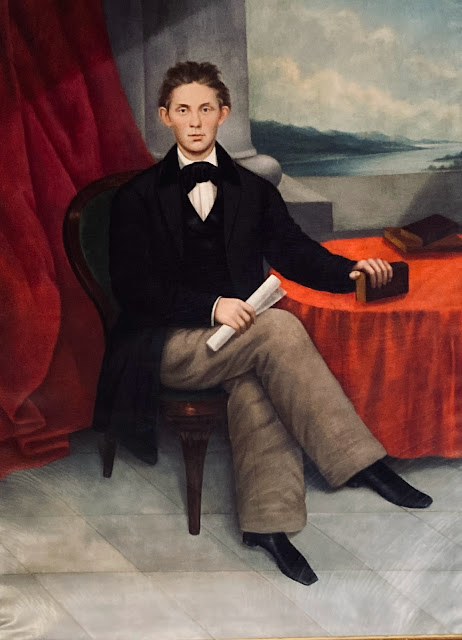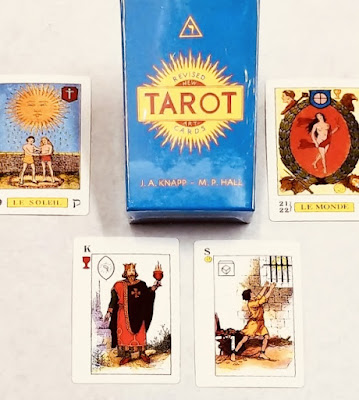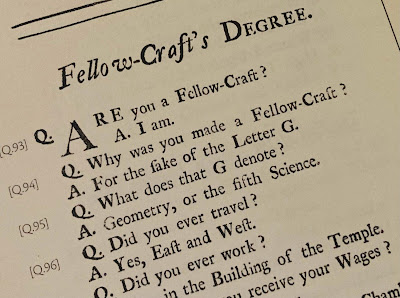Issue 58 (Fall 2022) of The Journal of the Masonic Society has been out several weeks; I just finished reading it, and am delighted to report it is another enlightening and entertaining collection of articles.
Sunday, October 23, 2022
‘Journal 58: Masonic beginnings and ends’
Issue 58 (Fall 2022) of The Journal of the Masonic Society has been out several weeks; I just finished reading it, and am delighted to report it is another enlightening and entertaining collection of articles.
Friday, October 21, 2022
‘Masonry: History and Characters Through Philately'
News today from the Masonic Philatelic Club concerns a new ebook that illustrates the history of Freemasonry via philately.
Alvaro Montoya Merino of Colombia has published Masonry: History and Characters Through Philately, a 319-page guided tour through 2000 postage stamps. Surely a labor of love.
From the publicity:
The present work, collects more than 2000 postage stamps with 1200 Masonic characters, presented in ten groups according to their activities and achievements that ended up changing our history.
I think the author has made some mistakes in the Famous Masons department, but these pages share stamps from around the world and back into the past. It’s comprehensive, with thousands of images, and even includes papal anti-Masonry.
Read it here.
Tuesday, October 18, 2022
‘Fez photos wanted!’
Monday, October 17, 2022
‘Masons and obelisks in NYC’
“These Freemason Obelisks in NYC Align?!” is a one-minute video uploaded to YouTube yesterday, already garnering tens of thousands of views and thousands of likes, purporting to illustrate a linear placement of “Masonic obelisks” along a longitudinal stretch of Manhattan.
Sunday, October 16, 2022
‘Loyalty and Kindness on research lodge’s agenda’
 |
| Williamsburg Lodge 6 |
Civil War Lodge of Research is heading to Colonial Williamsburg for its next communication.
 |
| Colonial Williamsburg |
Tuesday, October 11, 2022
‘The ALR in two weeks’
Sunday, October 9, 2022
‘Masonic art contest winners'
 |
GL of Pennsylvania ‘Renovatio Ritus, Dedication,’by Madeline Davis. |
The artists says “This is documentation of the ritual vessel Dedication in use. Renovatio Ritus is a renewal ritual, asking for Clarity, Truth, and Dedication. We find ourselves in search of answers, so we turn to religion, dogmas, and science to satiate our need to know all, yet we will never will.” It’s yours for $400.
Saturday, October 8, 2022
‘Knapp-Hall tarot to return again’
No details were given, but a brief remark on social media Thursday promises the return of the elusive Knapp-Hall tarot deck.
Friday, October 7, 2022
‘BBC: The Templaaars!’
Last night, BBC 4’s In Our Time program reviewed the historic Knights Templar in a conversation among scholars who also refuted the notion, popular among some Freemasons, that the medieval warriors were the ancestors of Masonry.
Thursday, October 6, 2022
‘R.I.P. masonicdictionary.com’
Something last week reminded me of the venerable masonicdictionary.com, and upon venturing to visit, I found it was no more. Stephen Dafoe, the creator of the—I’ll call it—innovative resource, left Freemasonry years ago, so I guess it is understandable how he may have tired of paying to maintain the site and domain.
Sunday, October 2, 2022
‘Pamela Colman Smith at the Whitney'
 |
| A.E. Waite |
Friday, September 30, 2022
‘Lodge by lantern light’
 |
| Warren Lodge 32’s Masonic Hall was built in 1865 in the Italianate style. It was relocated to its present site in 2011. |
I’ll conclude September with my scattered recollections of a terrific night seven weeks ago at Warren Lodge 32 way up in Schulztville for the occasion of a most enjoyable festive board by lantern light.
Warren 32 is New York’s last remaining “moon lodge,” meaning a lodge that meets on or about the night of the full moon. This special festive board was hosted on Saturday the thirteenth, which actually was two nights after August’s full moon (a Sturgeon Moon), so the convenience of the guests was accommodated by waiting for the weekend. And we guests turned out in force. I think I counted about sixty seated around the U-shaped “lodge” outdoors under the tent, and the travelers greatly outnumbered our hosts. A caravan of Grand Lodge officers, headed by Grand Master Kessler and Deputy Grand Master Rubin, arrived, obviously having come from a previous event somewhere.
Other brethren visited from around New York, New England, and elsewhere. I was invited to sit between Masons from New Hampshire and Massachusetts. There’s clearly a special energy present when meeting traveling Masons and being able to talk about things in common, however small. I told the brother from New Hampshire that I had been to the Manchester Temple two months prior for Masonic Con, and told the Massachusetts brother about my visits to two lodges on Cape Cod last year. Conversely, I was told about a tour of Masonic Hall in Manhattan.
 |
| Portrait of Augustus Schultz hangs in the East. |
The Warren Lodge brethren made this a history nerd-friendly event. They had a brother appear in the character of Bro. Augustus Schultz, the benefactor of the lodge who died too young at 26 in the 1860s, and bequeathed to Warren Lodge the funds that enabled it to purchase the land and construct the meeting hall where Warren was at labor until 2011. (Bro. Schultz did likewise for a local church.) That’s Schultz, as in Schultzville, the lodge’s original hometown until the building was picked up and relocated half a mile north to stand next to the Clinton town hall.
 |
| A small altar, as was furnished centuries ago. |
 |
| The U.S. flag featured fifteen stars from 1795 to 1818. |
Thursday, September 29, 2022
‘1730 Fellow-Craft’s Degree’
Thank you for reading The Magpie Mason. Today, we begin our fifteenth year together.
Publicity Lodge 1000 returned from its Summer Refreshment on Monday the twelfth, beginning a new year of Masonic labor. The Magpie Mason was scheduled to present a discussion of Masonic educational value, so, with a Ceremony of Passing on the trestleboard for an upcoming meeting, I chose the Fellow Craft Degree as that topic of conversation. And not just any second degree, but the one printed in 1730 by one Samuel Prichard in his essential ritual exposure Masonry Dissected, newly published by the Masonic Book Club. Masonic rituals, Masonic lodges, Masonic grand lodges, Masonic everythings were very different 300 years ago. All of it was very basic compared to what we have today.
I explained how when Masons think of lodges, we understandably envision the modern lodge room, with its varied furniture, seating arrangement, equipment, décor, etc., but things were primitive in the early eighteenth century when lodges met in tavern dining rooms or in private homes. There were no tall pillars flanking the Inner Door (there was no Inner Door!), and instead the brethren spoke ritually of J and B, explaining their purposes and describing their looks, using language similar enough to what we know today.
I told the lodge I was going to read the ritual of the degree. Read the ritual?! That could take hours! Yet the ritual of that period was very basic as well, consisting of a call-and-response dialog among the Worshipful Master and the brethren (not unlike our current Opening and Closing rituals) that spans only five pages of the MBC edition. The Fellow Craft Degree of 1730 included no elaborate floor work, no lengthy monolog lecture or other ceremonious orations, no hoodwink, nor other elements we today expect. Some of those features already were revealed to the candidate during the “Enter’d ’Prentice’s Degree,” and so went forsaken in the second degree. Anyway, reading the entire “Fellow-Craft’s Degree” ritual required only a couple of minutes. I won’t transcribe it all here, but do recommend to you the new book from the MBC. They will have more copies for sale after the subscription sales have been satisfied. (I saw Lewis Masonic had it listed for sale the other day, but it seems to be gone from their website now.)
Unsurprisingly, the letter G is very significant to the degree. I’ll share this brief passage. It rhymes and is in question-and-answer form. The dialog is between the Master and different brethren in the lodge (not the candidate, who wouldn’t be capable of answering), so you really had to know your ritual because you wouldn’t know which answers you’d be expected to recite on any given evening.
Q. Can you repeat the letter G?
A. I’ll do my endeavor. In the midst of Solomon’s Temple there stands a G, a letter fair to all to read and see, but few there be that understands what means that letter G.
Q. My friend, if you pretend to be of this fraternity, you can forthwith and rightly tell what means that letter G.
A. By sciences are brought to light bodies of various kinds, which do appear to perfect sight, but none but males shall know my mind.
Q. The Right shall.
A. If Worshipful.
Q. Both Right and Worshipful I am, to hail you I have command, that you do forthwith let me know, as I you may understand.
A. By Letters Four [the Word of EA] and Science Five [the fifth science, Geometry] this G aright does stand, in a due art and proportion, you have your answer, friend.
Q. My friend, you answer well, if Right and Free Principles you discover, I’ll change your name from friend, and henceforth call you Brother.
A. The Sciences are well composed of noble structure’s verse, a Point, a Line, and an Outside, but a Solid is the last.
Q. God’s good greeting be to this our happy meeting.
A. And all the Right Worshipful Brothers and Fellows.
Q. Of the Right Worshipful and Holy Lodge of St. John’s.
A. From whence I came.
Q. Greet you, greet you, greet you thrice, heartily well, craving your name.
A. (Candidate gives his name.)
Q. Welcome, Brother, by the grace of God.
Wednesday, September 28, 2022
‘The great mission of our fraternity’
The hundredth anniversary of the constitution of my lodge is a month away, so I am reading about that occasion and about the concurrent activities of Freemasonry in the State of New York. The latter is particularly impressive.
 |
| MW Arthur S. Tompkins |
 |
| Arthur Tompkins cocktail |
Wednesday, September 21, 2022
‘Bolívar’s Scottish Rite regalia’
One week from tomorrow, the Chancellor Robert R. Livingston Masonic Library will host an online discussion of the Scottish Rite regalia owned by Bro. Simón Bolívar. Bro. Alexander Vastola, Director of the library, will be the presenter, explaining Bolívar’s Masonic life, and how his Thirty-Second Degree collar and apron became the property of the library.
 |
| Central Park Conservancy |


















































































